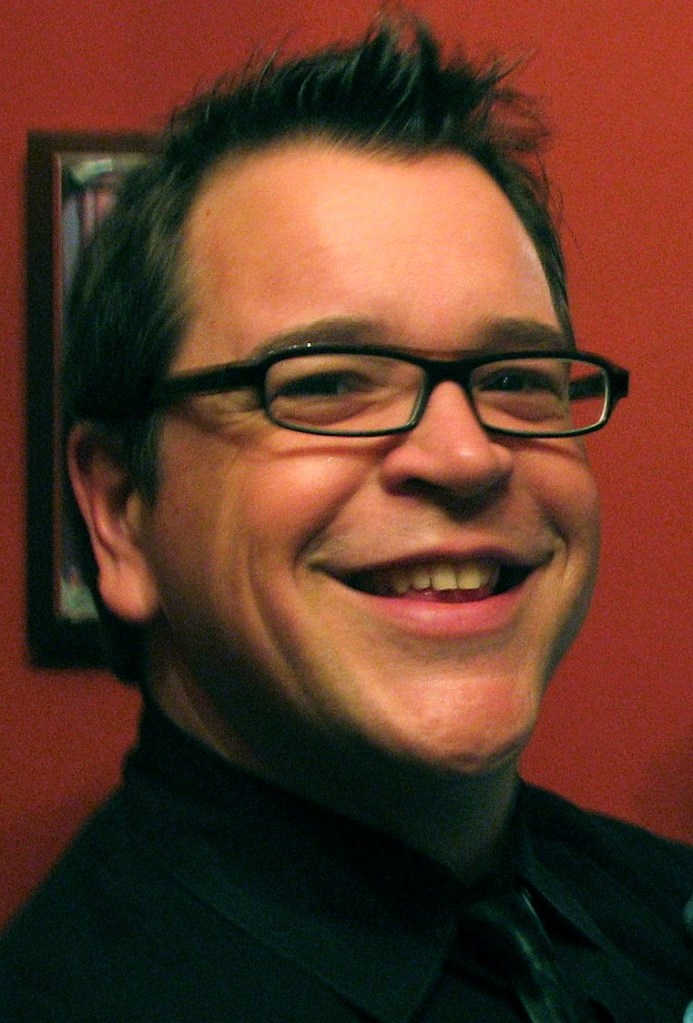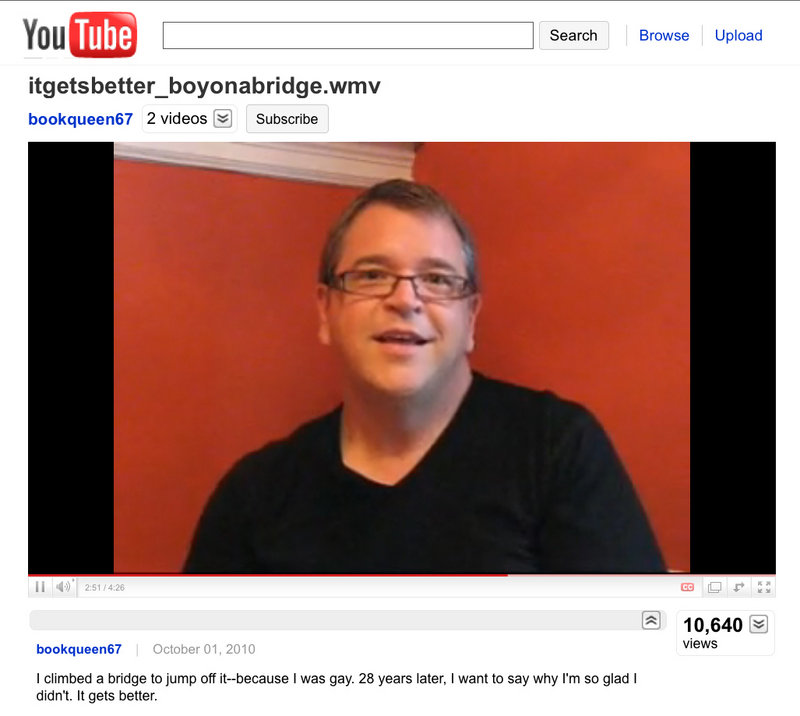NEW YORK – David Valdes Greenwood was 15 when he climbed to the highest arch of a bridge in his small Maine town and got ready to jump.
It was 1982. He was distraught over a pastor’s Sodom and Gomorrah sermon that his homosexuality would bring God’s wrath down on everyone around him. He didn’t think his friends, family and fellow churchgoers deserved to suffer because he was gay.
“It had never occurred to me that I would wound people by my simply existing,” Greenwood said. “And it seemed kind of true.”
So he became that boy on the Sophie May Lane Bridge in Norridgewock. Thankfully, a neighbor walked by and shouted for him to stop fooling around up there — and he listened, then fled town the first chance he got.
All grown up, married to a man he loves with a 5-year-old daughter they adore, the 43-year-old Greenwood hopes gay young people in pain will now listen to him. So do hundreds of others who, like Greenwood, have taken to YouTube to make a promise: If you hang on through the self-doubt, the coming out years, through the slurs, the isolation at school and being slammed up against the lockers, through the rejection and anger of parents and grandparents, it gets better. A whole lot better.
Moved by a recent spate of suicides by teenagers who were believed to be victims of anti-gay bullying, syndicated relationship and sex advice columnist Dan Savage began the YouTube project on Sept. 21, hoping it would turn into exactly what it is: a destination for gay young people to receive comfort from a variety of perspectives on their Internet home turf.
There’s a gay cop and an ex-Mormon, a young Muslim from a conservative Pakistani home, gay parents showing off photos of their kids and an openly gay Baptist minister.
Mixed in with somber stories of suicide attempts are a sassy lesbian cartoon, a video with gay men surrounded by shirtless male hotties, and a sprinkling of celebrities: Ellen DeGeneres, Tim Gunn from “Project Runway,” Chris Colfer from “Glee” and blogger Perez Hilton, who went to a Jesuit high school in Miami.
There are gay people who confess THEY were the bullies and people with guitars singing. Cities and campuses (San Francisco, Smith College) are represented. There’s also a lot of anger and frustration that the middle and high school years for so many gay youths haven’t changed all that much since Greenwood was a kid.
“I really, really believed that kids killing themselves over being gay was a relic of another time,” said Greenwood, a writer and English instructor at Tufts University. “I mean, it was nearly 30 years ago when I climbed my bridge. I thought that even kids who were bullied now had online communities or other ways of feeling hope about their identities.”
Savage, a gay rights activist who also writes books, travels the country speaking, but knows many towns and schools will never invite him. That’s one reason he set up the “It Gets Better” channel on YouTube and asked for video stories, starting with himself and his partner, Terry.
In two weeks, the channel has racked up more than a million views, the number of videos has exploded from a handful to 1,000 submitted, comment threads are growing and e-mails are pouring in from bullied and closeted teenagers.
“We’re totally overwhelmed by the response,” Savage said. “The most gratifying are parents sitting down at the computer and watching with their kids. So many kids, they’re bullied at school by their peers, they go home to homophobic parents who bully them, and then they’re dragged to church on Sunday for more bullying from the pulpit.”
Savage knew the power of his own story, his years in Catholic boys schools as the son of a church deacon and a lay minister.
“High school was bad,” Savage said. “I was picked on because I liked musicals. I was obviously gay.”
But his parents came around. So did his partner’s family in Spokane, Wash., where Terry was stuffed into bathroom stalls and school officials dismissed his parents’ complaints about bullying as a natural consequence of being gay. They’ve been together 16 years and adopted their 12-year-old son, D.J., at birth.
“I didn’t think when I came out to my parents in the very early 1980s when AIDS was slamming into the gay community that I would ever be a dad,” Savage said in their video.
Nicholas Wheeler, a graphic designer who grew up Mormon in Idaho, said he made his video because he knows that other kids from conservative, religious backgrounds “don’t make it out alive. It breaks my heart.”
Wheeler, 26, said being gay didn’t fit into the picture in his head of how his life would turn out. In deep denial for years, he didn’t come out until 2008, after going on a two-year church mission trip at 20. He had to dismiss his thoughts “of gay people as evil and unhappy.”
His turning point came after he moved to Salt Lake City, where he met lots of gay ex-Mormons, and stopped thinking of himself as a sinner. Things aren’t perfect, but “I’m leaps and bounds happier than I was,” he said in an interview.
So is 28-year-old Bruce Ortiz, who works in marketing in Chicago. He tried to kill himself with a bottle of pills as a freshman in college. Healing was slow but steady after he opened up to his parents about being gay. He and his partner just bought a house together and are thinking about starting a family.
Ortiz’s video message to young people: “It’s not worth the attempt. Just go out there, find your support system, find that support system within yourself, because life does get better.”
Send questions/comments to the editors.




Success. Please wait for the page to reload. If the page does not reload within 5 seconds, please refresh the page.
Enter your email and password to access comments.
Hi, to comment on stories you must . This profile is in addition to your subscription and website login.
Already have a commenting profile? .
Invalid username/password.
Please check your email to confirm and complete your registration.
Only subscribers are eligible to post comments. Please subscribe or login first for digital access. Here’s why.
Use the form below to reset your password. When you've submitted your account email, we will send an email with a reset code.